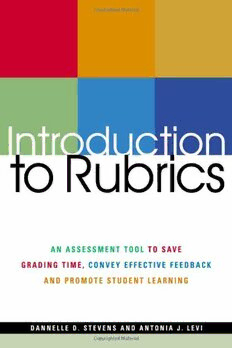Download Introduction To Rubrics: An Assessment Tool To Save Grading Time, Convey Effective Feedback and Promote Student Learning PDF Free - Full Version
Download Introduction To Rubrics: An Assessment Tool To Save Grading Time, Convey Effective Feedback and Promote Student Learning by Dannelle D. Stevens, Antonia J. Levi in PDF format completely FREE. No registration required, no payment needed. Get instant access to this valuable resource on PDFdrive.to!
About Introduction To Rubrics: An Assessment Tool To Save Grading Time, Convey Effective Feedback and Promote Student Learning
You need rubrics if:* You find yourself repeating the same comments on most student papers* You worry that you’re grading the latest papers differently from the first* You’re concerned about communicating the complexity of a semester-long assignment* You question the consistency of your and your colleagues’ grading scales * Grading is taking up far too much of your valuable timeResearch shows that rubrics save professors time while conveying meaningful and timely feedback for students, and promoting self-regulated and independent learning. The reason rubrics are little used in higher education is that few faculty members have been exposed to their use.At its most basic a rubric is a scoring tool that divides an assignment into its component parts and objectives, and provides a detailed description of what constitutes acceptable and unacceptable levels of performance for each part.Rubrics can be used to grade any assignment or task: research papers, book reviews, participation in discussions, laboratory work, portfolios, oral presentations, group work, and more.This book defines what rubrics are, and how to construct and use them. It provides a complete introduction for anyone starting out to integrate rubrics in their teaching.The authors go on to describe a variety of processes to construct rubrics, including some which involve student participation.They demonstrate how interactive rubrics--a process involving assessors and the assessed in defining the criteria for an assignment or objective--can be effective, not only in involving students more actively in their learning, but in establishing consistent standards of assessment at the program, department and campus level.
Detailed Information
| Author: | Dannelle D. Stevens, Antonia J. Levi |
|---|---|
| Publication Year: | 2004 |
| ISBN: | 9781435617261 |
| Pages: | 142 |
| Language: | English |
| File Size: | 0.469 |
| Format: | |
| Price: | FREE |
Safe & Secure Download - No registration required
Why Choose PDFdrive for Your Free Introduction To Rubrics: An Assessment Tool To Save Grading Time, Convey Effective Feedback and Promote Student Learning Download?
- 100% Free: No hidden fees or subscriptions required for one book every day.
- No Registration: Immediate access is available without creating accounts for one book every day.
- Safe and Secure: Clean downloads without malware or viruses
- Multiple Formats: PDF, MOBI, Mpub,... optimized for all devices
- Educational Resource: Supporting knowledge sharing and learning
Frequently Asked Questions
Is it really free to download Introduction To Rubrics: An Assessment Tool To Save Grading Time, Convey Effective Feedback and Promote Student Learning PDF?
Yes, on https://PDFdrive.to you can download Introduction To Rubrics: An Assessment Tool To Save Grading Time, Convey Effective Feedback and Promote Student Learning by Dannelle D. Stevens, Antonia J. Levi completely free. We don't require any payment, subscription, or registration to access this PDF file. For 3 books every day.
How can I read Introduction To Rubrics: An Assessment Tool To Save Grading Time, Convey Effective Feedback and Promote Student Learning on my mobile device?
After downloading Introduction To Rubrics: An Assessment Tool To Save Grading Time, Convey Effective Feedback and Promote Student Learning PDF, you can open it with any PDF reader app on your phone or tablet. We recommend using Adobe Acrobat Reader, Apple Books, or Google Play Books for the best reading experience.
Is this the full version of Introduction To Rubrics: An Assessment Tool To Save Grading Time, Convey Effective Feedback and Promote Student Learning?
Yes, this is the complete PDF version of Introduction To Rubrics: An Assessment Tool To Save Grading Time, Convey Effective Feedback and Promote Student Learning by Dannelle D. Stevens, Antonia J. Levi. You will be able to read the entire content as in the printed version without missing any pages.
Is it legal to download Introduction To Rubrics: An Assessment Tool To Save Grading Time, Convey Effective Feedback and Promote Student Learning PDF for free?
https://PDFdrive.to provides links to free educational resources available online. We do not store any files on our servers. Please be aware of copyright laws in your country before downloading.
The materials shared are intended for research, educational, and personal use in accordance with fair use principles.

